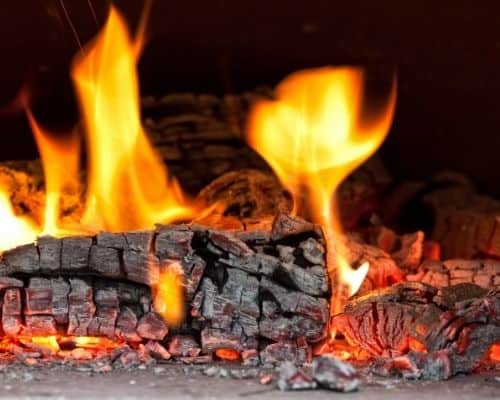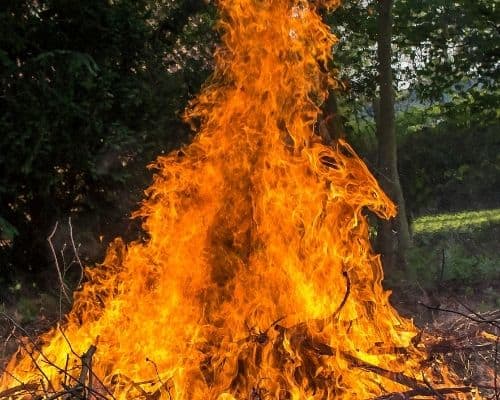To a bystander, fire is fire, but a fire actually progresses across four stages. Even though civilians shouldn’t attempt to combat fires themselves, it’s still good to know what the various fire stages are as told by a firefighter. How does a fire progress?
Fires start in the ignition or incipient stage before growing, which is the second stage. By the third stage, the fire has become fully developed. With time or firefighter intervention, the fire will enter the fourth stage, which is decay.

In today’s article, we’ll discuss in far more detail the four stages of fire, including what causes one stage to advance to another. Make sure you keep reading!
Table of Contents
The 4 Stages of Fire
Ignition
At its simplest, fires begin when combining oxygen with combustible or flammable materials. If not oxygen itself, oxygen compounds or oxygenated gas can be used in its place.
When a fire ignites, it’s in the first stage of four. This stage is also known as the incipient stage. Incipience refers to the starting stages of something, so it’s the perfect name for this first fire phase.
The fire has just started, but it will spread as it finds more oxygen sources to consume. If you see an ignition fire on your premises or in another building, you should still evacuate immediately, even if the fire doesn’t yet look large. After all, it’s only a matter of time before the fire will move onto the second stage, which is growth.
During the ignition or incipient phase, the flames will be below ceiling height. They will usually only stay in the area in which the fire occurs, but as we just touched on, the flames can and will spread.
The heat of the fire is considered close to ambient temperatures. If a firefighter used a thermal imaging camera on an ignition fire, the camera might not even be able to generate a heat signature.
There’s some smoke present during an ignition fire, but it’s not very buoyant or thick. The color of the smoke would be light gray or white instead of dark gray to black.
After evacuating due to an ignition fire, call emergency services. The fire department will be deployed to your location right away. Since ignition fires are still in the incipient stage, extinguishing them is easier for firefighters.
Combatting the fire now can prevent it from spreading elsewhere and possibly getting out of control. The fire department can also minimize the rate of property damage.
Growth
If you don’t spot a fire in its ignition stage or if you do but you don’t do anything about it quickly enough, then as we said, that ignition fire will soon become a growth fire. This is the second of the four stages of fire.
Some household fire detectors only go off once a fire reaches the growth stage, which is problematic. By now, the fire has increased by a sizable degree. It hasn’t reached its full form yet, but it’s steadily getting there.

The flames of a growth fire can easily touch the ceiling. In some instances, the flames will even bend and move horizontally across a ceiling, which is scary to witness, especially as a civilian.
Temperatures will have increased beyond the ambient range, but only in the areas of the home or building in which the fire is currently burning. Hot smoke will have accumulated as well and can reach nearby compartments.
The fire is harder to control than it was in its ignition stage since it’s started to consume oxygen or other flammable materials and has spread. While you might have been able to toss a fire blanket on a small ignition fire and then leave, by the time the fire reaches the growth stage, your best plan of action is to just evacuate yourself, your family or loved ones, and your pets if you can.
Once again, call emergency services and wait for the firefighters to arrive on the scene. Although it’s harder for the fire department to put out a fire in the growth stage, it’s not impossible by any means.
Depending on how far the fire has spread, damage to surrounding buildings and structures could be likely. Your property might be destroyed as well if the growth fire is severe enough.
Full Development
The third stage of a fire is known as full development. This is by far the most severe of the four stages.
As the name full development tells you, the fire is not going to get any larger than it is at this point. The temperature of the flames is at its max, so the fire is likely burning closer to 2,000 degrees Fahrenheit.
The size of the flames is also large. Between the heat damage from the excessively high temperatures and the fire damage as the flames grow larger and higher, full development fires can be absolutely catastrophic.
The flames are isolated during a full development fire and can easily cross the ceiling, much as is the case with a growth fire. Smoke can be thick and dark in colors such as black, brown, and dark gray. The volume of the smoke will also increase, which will further reduce visibility.
Immediate evacuation if it’s possible must be mandated for your survival. Growth fires are dangerous, but full development fires are the most likely to cause loss of life. Property damage can leave you with a burnt husk rather than a happy family home.
This highly oxygenated fire will keep going and going, seeking out more flammable surfaces to engulf. An uncontrolled full development fire can easily spread to adjacent properties and continue burning, seemingly endlessly.
You should still contact your local fire department even if the fire on your property has advanced to a full development fire. Standing by and allowing the building to burn is within no one’s best interest. Although it might be too late to save your home, by allowing the fire to do its thing, you’re feeding it more flammable materials so it continues burning stronger.
The firefighters will be able to tamp down the blaze, but a full development fire is the hardest to combat, so it can take a while.
Decay
That brings us to the fourth stage of a fire, which is decay. As a fire burns, it will eventually run out of oxygen or flammable materials to ingest so it can keep burning. How long that takes depends on where the fire originates from.

For example, if a fire is burning through a forest or a city, then there are plenty of materials to continue stoking the flames. When there’s nothing left because the fire engulfed it all, then the fire would become a mere smolder before petering out entirely.
What Is a Flashover Fire?
Some fire departments describe the stages of fire as 4.5 or five stages rather than four. The extra stage or sub-stage is known as flashover fire.
A flashover fire will occur between the first and second stages of the fire, which are the ignition and growth stages. The fire grows beyond what it should in the second stage, typically due to the proximity of fuel or other sources of fire ignition.
According to the National Fire Protection Association or NFPA, flashovers are “a transitional phase in the development of a compartment fire in which surfaces exposed to thermal radiation reach its ignition temperature more or less simultaneously and fire spreads rapidly throughout the space resulting in full room involvement or total involvement of the compartment or enclosed area.”
Besides combustible materials being close by, other factors can dictate whether a fire develops into a flashover. For instance, the number of openings such as windows and doors is one such factor, as is the height of these openings.
If the ambient temperature of the fire is already high to start, that can push a fire past the ignition stage into a flashover fire. So too can the rate of heat gain, with heat loss having to be minimized for a flashover to occur.
The volume, area, shape, and size of the compartment also play a major role in starting or sustaining flashover fires.

How do firefighters combat flashover fires? They can place vertical and/or horizontal vents to bring down the amount of heat in the compartment. By venting the smoke, the compartment is more easily visible, which also helps.
Using a hose line is another viable solution, as is a portable fire extinguisher that can reduce the amount of heat in the compartment, even as it burns.
For civilians, you should know that flashover fires are extremely, extremely dangerous. They can cause severe injuries and even loss of life. When a flashover fire is about to start, it can take only 10 seconds for it to become very serious.
That’s why rather than try to stay and combat a fire or gather personal belongings, you should always evacuate the premises immediately. This can protect you from a flashover fire and save your life!
What is a Fire Whirlwind? How Likely Are They?
Speaking of horrifying fire phenomena, we thought we’d wrap up by discussing fire whirlwinds, which yes, are a real thing.
Referred to as fire devils and even sometimes fire tornados (although they are technically not tornados), a fire whirlwind is exactly what it sounds like. A moving air pocket with a burning fire core picks up momentum, mostly due to the inclusion of ash.
The temperature of a fire whirlwind can easily exceed 2,000 degrees, so we’re sure we don’t have to tell you how very dangerous they are.
Types of Fire Whirlwinds
Not all fire whirlwinds are the same. Firefighting professionals currently acknowledge three whirlwind types. The first is Type 1, which means the fire whirlwind is staying over an area that’s already burning. This type of whirlwind, which still terrifying, is considered stable.

Type 2 fire whirlwinds have now moved downwind of the original burning area. They’re thus transient but still stable. Type 3 fire whirlwinds can travel even further but are–you guessed it–stable.
What Causes Fire Whirlwinds?
The good news is that fire whirlwinds don’t just happen. You’re likely to see them during or after a volcanic eruption, especially near the plumes. Wildfires can also create fire whirlwinds in their wake, especially if the burning fire converges with hot updrafts.
Most fire whirlwinds don’t last very long. The ones that are 100 feet tall burn out in a couple of minutes. Taller whirlwinds are more than a mile in height and can reach speeds well over 100 miles per hour. These can take upwards of 30 minutes to burn out on their own.
Conclusion
Fires burn in four stages: the ignition stage, the growth stage, the full development stage, and finally, the end of the fire or the decay stage. How long it takes for a fire to transition from one stage to another depends on the availability of flammable materials.
Since risks like flashover fires are possible as a fire grows, you should always try to get out of a building that’s on fire as soon as you can!
